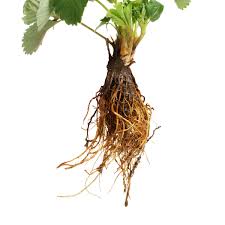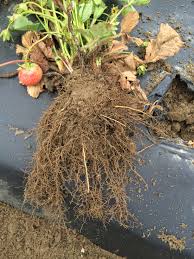Strawberry roots refer to the underground structures of the strawberry plant (Fragaria spp.) that play a crucial role in the plant’s growth, nutrient uptake, and overall health. The strawberry plant is a perennial herbaceous plant that produces the well-known and delicious red fruits called strawberries.
The primary function of roots is to absorb water and essential nutrients from the soil. This process is crucial for the plant’s growth, development, and overall survival. Strawberry roots also act as a storage site for carbohydrates and other nutrients. These stored reserves help the plant survive adverse conditions such as winter or periods of drought.
Strawberry roots are generally fibrous, shallow, and spread out wide, extending horizontally just below the soil surface. The shallowness of the root system makes strawberries vulnerable to drying out quickly in arid conditions, necessitating regular watering.
For commercial strawberry cultivation, proper care of the root system is essential. Farmers often employ techniques such as mulching, which involves placing a layer of organic material on the soil surface, to help retain moisture and maintain a stable root environment.
Strawberry roots are a vital component of the plant’s structure and function. They support the plant, absorb water and nutrients, store reserves, and facilitate essential interactions with the surrounding soil and microorganisms, all of which contribute to the healthy growth and production of the iconic strawberry fruits.
The Economic Importance and Uses of Strawberry Roots

Strawberry roots, while often overlooked compared to the fruit they support, do possess some economic importance and uses. However, it’s important to note that strawberry plants are typically propagated through runners (stolons) rather than from root cuttings, so the utilization of strawberry roots might not be as prominent as other parts of the plant.
Here are some potential economic importance and uses of strawberry roots:
1. Soil Stabilization and Erosion Control: Strawberry plants have a fibrous root system that helps hold soil in place, reducing erosion on slopes and along waterways. This can be especially important for landscaping and agricultural purposes, helping to prevent soil loss and maintain the health of surrounding ecosystems.
2. Horticultural Research: Researchers and plant breeders might study strawberry roots to better understand their physiology, nutrient uptake, and resistance to diseases. This information can aid in the development of more robust and disease-resistant strawberry cultivars, benefiting the agricultural industry.
3. Medicinal and Nutraceutical Uses: While not as common as other plant parts, strawberry roots have been used in traditional medicine for various purposes. They are believed to possess anti-inflammatory and diuretic properties. Extracts from strawberry roots might have potential applications in herbal remedies or nutraceutical products.
4. Composting and Soil Improvement: Strawberry roots, like other plant material, can be composted and used to improve soil quality and fertility. Adding roots to compost can enhance its nutrient content and help maintain a healthy soil ecosystem, ultimately benefiting agriculture and gardening.
5. Cultural and Artistic Uses: In some cultures, plant roots have been used for weaving baskets, creating dyes, or making traditional crafts. While not specific to strawberry roots, if these skills are part of a local heritage, strawberry roots could potentially find use in such activities.
Read Also: Strawberry Crown: Economic Importance, Uses and By-Products
6. Natural Erosion Control Products: Some companies produce erosion control products using natural fibers, including plant roots. While this is not commonly associated with strawberry roots, their fibrous nature could potentially make them suitable for inclusion in such products.
7. Educational and Demonstration Purposes: Strawberry roots can be used for educational purposes, such as in botany classes or gardening workshops. Studying the root system can provide insights into plant growth and development, making it a valuable tool for teaching about plant biology.
8. Wildlife and Habitat Support: In natural settings, strawberry plants contribute to the overall biodiversity of ecosystems, providing habitat and food sources for various animals, insects, and microorganisms. Conserving natural strawberry habitats indirectly supports these ecosystems and the services they provide.
9. Bioremediation and Soil Health: Strawberry plants, including their roots, can be used in phytoremediation efforts. This involves using plants to remove pollutants and contaminants from soil and water. While not a widely recognized use for strawberry roots, their potential for phytoremediation could contribute to environmental cleanup efforts in certain contexts.
10. Cultural and Traditional Uses: In some cultures, various parts of plants hold cultural or spiritual significance. While there isn’t widespread documentation of strawberry roots having specific cultural uses, it’s possible that in certain traditions, they might hold symbolic importance or be integrated into rituals.
11. Research and Biotechnology: Researchers might study the genetics of strawberry roots to gain insights into plant development, growth patterns, and nutrient absorption. This knowledge can be used to develop agricultural techniques and biotechnological advancements that improve crop yields and sustainability.
12. Crafts and Art Projects: As with other plant roots, strawberry roots could potentially be used in crafting, especially in projects that require natural materials. They might be used in decorative elements, sculptures, or other artistic creations.
13. Erosion Control Blankets: In erosion-prone areas, erosion control blankets made from natural fibers are often used to stabilize soil and encourage plant growth. While not a common application, strawberry roots’ fibrous structure could contribute to the composition of these blankets.
14. Local and Niche Markets: In some regions, niche markets and small-scale businesses may develop unique products from strawberry roots, such as herbal remedies, teas, or decorative items. These products might cater to specific consumer preferences for natural and locally sourced goods.
15. Organic Fertilizer Production: Strawberry roots, like other plant materials, can be composted to create organic fertilizer. This fertilizer can enhance soil fertility and structure, promoting healthy plant growth without the use of synthetic chemicals.
The Products and By-products That Can Be Derived From Strawberry Roots

While strawberries are primarily known for their delicious fruits, various products and by-products can be derived from their roots as well. It’s important to note that the use of strawberry roots for these purposes might not be as common or well-established as using other parts of the plant, and research or traditional practices may vary.
Here are some potential products and by-products that can be derived from strawberry roots:
1. Herbal Remedies: Strawberry roots have been used in traditional herbal medicine for their potential health benefits. They might be used to make infusions or decoctions for various purposes, such as digestive support, diuretic effects, or anti-inflammatory properties.
2. Dyeing: The roots of some plants, including strawberries, can be used to create natural dyes. The roots might yield colors ranging from light yellows to earthy tones. The dyeing process usually involves boiling the roots and using the resulting liquid to dye fabrics or other materials.
3. Flavorings: Strawberry roots might contain compounds that contribute to flavor or aroma. However, extracting flavors from roots can be more challenging than from other parts of the plant, and this use is not as common.
4. Crafts and Art: Strawberry roots could potentially be used in crafts and art projects. They might be used for making natural ornaments, sculptures, or other creative items.
5. Composting: Once strawberry plants have reac hed the end of their productive life cycle, their roots can be composted. Composting strawberry roots along with other organic materials can help enrich the soil with nutrients, supporting the growth of future crops.
Read Also: Strawberry Runners: Economic Importance, Uses and By-Products
6. Soil Erosion Control: In some cases, plant roots, including strawberry roots, can be used for erosion control. The roots help stabilize soil and prevent it from washing away in areas prone to erosion.
7. Natural Insecticides/Fungicides: Some plants, including strawberry plants, contain compounds that may have pesticidal properties. Extracts from strawberry roots might have potential as natural insecticides or fungicides for use in organic gardening.
8. Mulch: Dried and shredded strawberry roots could potentially be used as a natural mulch in gardening. Mulch helps retain soil moisture, suppress weed growth, and maintain a more stable soil temperature.
9. Medicinal Extracts: Strawberry roots may contain bioactive compounds with potential health benefits. These compounds could be extracted and formulated into herbal supplements or natural remedies for various health conditions. However, extensive research is needed to establish their safety and efficacy.
10. Natural Cosmetics: Some natural cosmetics and skincare products incorporate plant extracts. Strawberry root extracts could potentially be used in skincare formulations due to their possible antioxidant and anti-inflammatory properties.
11. Traditional Practices: In traditional medicine systems, different parts of plants, including roots, are used for various purposes. In some cultures, strawberry roots might hold cultural or traditional significance, and they could be used in rituals or remedies.
12. Educational Purposes: Strawberry roots could be used for educational purposes in schools, botanical gardens, or science centers. Studying the roots could help individuals understand plant anatomy, growth patterns, and the role of roots in nutrient absorption.
13. Plant Propagation: While not a direct product, strawberry roots are essential for plant propagation. New strawberry plants can be grown from runners, which are stems that produce roots and eventually form new plants. These runners are often separated from the parent plant and planted to establish new strawberry beds.
14. Bioremediation: Some plants have the ability to accumulate or break down pollutants from soil. Strawberry roots might have potential in bioremediation projects, where they could be used to help clean up contaminated soils.
15. Research and Development: Scientists and researchers might study strawberry roots to understand their biochemical composition, potential compounds of interest, and other characteristics. This research could contribute to broader knowledge about plant biology, ecology, and potential applications.
16. Animal Feed: While less common, some plant roots are used as animal feed or fodder. Strawberry roots could potentially be used as a supplementary feed source for animals, although their nutritional value for this purpose would need to be evaluated.
In conclusion, remember that the feasibility, safety, and effectiveness of using strawberry roots for these purposes will depend on factors such as the specific variety of strawberry, cultivation practices, potential bioactive compounds, and more. Always consult relevant experts, conduct proper research, and consider sustainability and ethical factors when exploring alternative uses for plant parts.
